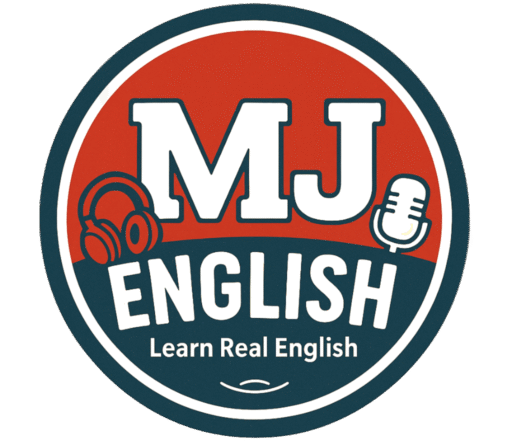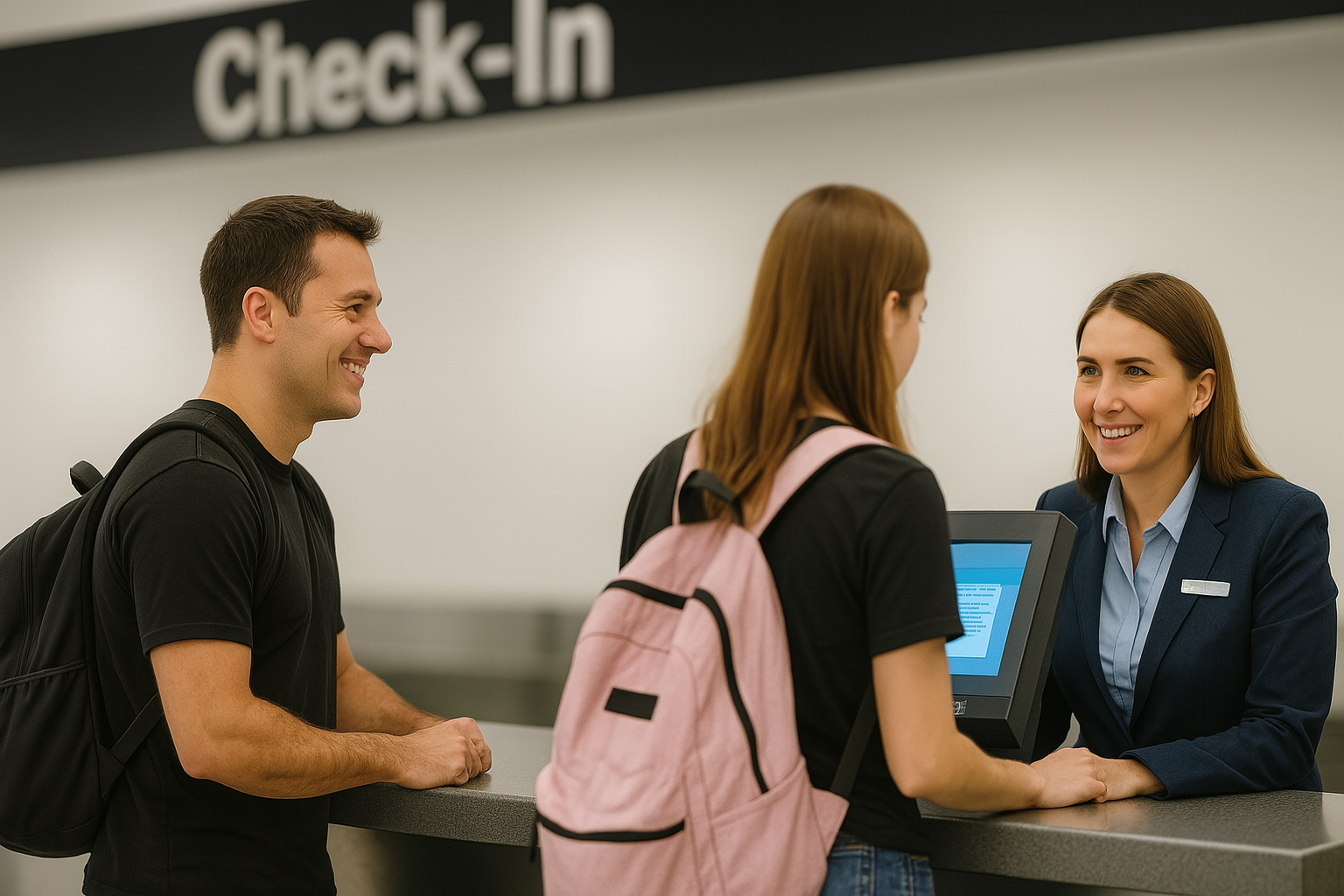你準備好登機了嗎?😎
✈️從「等候登機 → 確認座位 → 打開飛航模式」的英文會話情境。
超實用片語+生活用字,讓你輕鬆搞懂在機場該怎麼用英文自然聊天 🛬💬
https://open.spotify.com/episode/2FbdeHHd3EsqSGt8SGph0b?si=-zrIMWR6T-myQl52C5GHWQ
🧳 Lena and Eric are waiting to board their flight to Los Angeles.
Lena 和 Eric 正在等著搭機前往洛杉磯。
(Lena = L;Eric = E)
💬 Dialogue 對話內容
L: Looks like boarding will begin soon. Got everything?
E: 看起來快要開始登機了。都準備好了嗎?
E: Yep. I’ve got our passports, boarding passes, and your neck pillow.
E: 嗯,我帶了我們的護照、登機證,還有你的頸枕。
L: Thanks! Oh, did we get our seats next to each other?
L: 謝謝!欸,我們有安排坐在一起嗎?
E: We did. I picked 18A and 18B when I checked us in online last night.
E: 有的。我昨晚線上報到時選了18A和18B。
L: You’re the best. I really prefer the window.
L: 你真貼心。我真的比較想坐靠窗。
E: I know. You always like to take photos during takeoff.
E: 我知道,你每次起飛時都喜歡拍照。
L: Haha, guilty. Should we line up now?
L: 哈哈,沒錯。我們要現在去排隊嗎?
E: Not yet. They’re still boarding business class. Group 3 is next.
E: 還不用,他們還在讓商務艙登機,接著是第3組。
L: All right. I’ll just set my phone to airplane mode first.
L: 好的。我先把手機切到飛航模式。
E: Good idea. And maybe grab a piece of gum—for your ears.
E: 好主意。順便咬一片口香糖—保護一下耳朵(減輕或避免耳鳴)。
L: Already in my pocket!
L: 我口袋裡就有了!
🔑 重點單字
| 單字 | 詞性 | 解釋 | 例句 | 例句翻譯 |
|---|---|---|---|---|
| neck pillow | n. | 頸枕 | I always travel with my neck pillow for long flights. | 我總是在長途飛行時攜帶我的頸枕。 |
| check in (online) | v. | 線上報到/登機報到 | We checked in online and selected our seats yesterday. | 我們昨天在線上報到並選好了座位。 |
| takeoff | n. | 起飛 | The kids love looking out the window during takeoff. | 孩子們喜歡在起飛時從窗戶往外看。 |
| airplane mode | n. | 飛航模式 | Please switch all devices to airplane mode now. | 請立即將所有裝置切換到飛航模式。 |
| boarding group | n. | 登機組別 | We’re in boarding group 3, so we’ll wait a bit. | 我們是第三組登機,所以等一下再去。 |
🔎 焦點句型
| 句型 | 功能說明 | 英文例句 | 中文翻譯 |
| Looks like… | 觀察當下狀況/情境 | Looks like boarding will begin soon. | 看起來快要開始登機了。 |
| Did we get…? | 確認之前安排事項 | Did we get our seats next to each other? | 我們的座位有選在一起嗎? |
| I picked ___ when I… | 敘述「某時候」做了選擇 | I picked 18A and 18B when I checked us in online. | 我報到時選了18A和18B的座位。 |
| You always like to… | 描述對方習慣或偏好 | You always like to take photos during takeoff. | 你總是在飛機起飛時拍照。 |
| I’ll just… first. | 提出接下來會做的事 | I’ll just set my phone to airplane mode first. | 我先把手機調成飛航模式。 |
J: Hello, and welcome to MJ English.
J: 哈囉,歡迎來到 MJ English。
J: Today, we’re going to help you learn some really useful English for when you travel.
J: 今天我們要幫你學習一些在旅行時非常實用的英文。
J: Specifically, we’ll listen to a conversation about, uh, getting ready to board an airplane.
J: 具體來說,我們要聽一段有關準備登機的對話。
J: How we’ll do this is, first, we’ll listen to the short conversation itself.
J: 我們的做法是:首先,我們會先聽這段簡短的對話。
J: Then we’ll go through it bit by bit, explaining the important words and sentences just to make sure you understand everything clearly.
J: 接著我們會逐句解析,說明重要的單字和句子,確保你能清楚理解所有內容。
J: Okay, let’s set the scene.
J: 好,讓我們來設定場景。
J: Uh, imagine Lena and Eric—they’re at the airport waiting at the gate for their flight to Los Angeles.
J: 想像一下 Lena 和 Eric 正在機場,在登機門等候飛往洛杉磯的航班。
J: Let’s listen in.
J: 我們來聽聽看。
🧳 Lena and Eric are waiting to board their flight to Los Angeles.
Lena 和 Eric 正在等著搭機前往洛杉磯。
(Lena = L;Eric = E)
💬 Dialogue 對話內容
L: Looks like boarding will begin soon. Got everything?
E: 看起來快要開始登機了。都準備好了嗎?
E: Yep. I’ve got our passports, boarding passes, and your neck pillow.
E: 嗯,我帶了我們的護照、登機證,還有你的頸枕。
L: Thanks! Oh, did we get our seats next to each other?
L: 謝謝!欸,我們有安排坐在一起嗎?
E: We did. I picked 18A and 18B when I checked us in online last night.
E: 有的。我昨晚線上報到時選了18A和18B。
L: You’re the best. I really prefer the window.
L: 你真貼心。我真的比較想坐靠窗。
E: I know. You always like to take photos during takeoff.
E: 我知道,你每次起飛時都喜歡拍照。
L: Haha, guilty. Should we line up now?
L: 哈哈,沒錯。我們要現在去排隊嗎?
E: Not yet. They’re still boarding business class. Group 3 is next.
E: 還不用,他們還在讓商務艙登機,接著是第3組。
L: All right. I’ll just set my phone to airplane mode first.
L: 好的。我先把手機切到飛航模式。
E: Good idea. And maybe grab a piece of gum—for your ears.
E: 好主意。順便咬一片口香糖—保護一下耳朵(減輕或避免耳鳴)。
L: Already in my pocket!
L: 我口袋裡就有了!
J: Okay, a pretty typical airport chat, wouldn’t you say?
J: 好啦,這段對話是不是很典型的機場用語?
M: Definitely. Lots of useful language packed in there.
M: 完全沒錯,裡面有很多實用的表達。
J: Right. So let’s, uh, let’s break it down now, line by line. We’ll start with that first thing Lena says.
J: 沒錯。現在我們逐句來解析,先從 Lena 的第一句開始。
M: Looks like boarding will begin soon. Got everything?
M: 看來快要開始登機了。都準備好了嗎?
M: So she’s looking around, seeing what’s going on, and she thinks it’s almost time to get on the plane.
M: 她環顧四周,發現快要登機了,就問是不是都準備好了。
J: And then she quickly checks with Eric about their stuff.
J: 接著她馬上確認 Eric 是否帶好所有東西。
M: Yeah, “looks like” is a great way to start. You’re making an observation, you know, based on what you see—”looks like it’s our turn, maybe.” And “got everything,” that’s super common. Just means, “do you have all our important things ready?”
M: 沒錯,「looks like」是很好的開頭方式,用眼前所見推測。「got everything」也很常用,意思就是「我們的重要東西都準備好了嗎?」
J: Good point. Okay, then Eric replies—
J: 很好的解釋。接著 Eric 回答──
M: Yep, I’ve got our passports, boarding passes, and your neck pillow.
M: 有啊,我帶了護照、登機證,還有你的頸枕。
J: “Yep” is just a casual “yes,” right? Very natural.
J: 「yep」只是比較隨性的「yes」,很自然。
M: Totally. And he lists three things: passports, boarding passes, neck pillow.
M: 沒錯,他列了三樣:護照、登機證、頸枕。
J: Right. So passports—essential documents for going to another country, you need them.
J: 沒錯,護照是出國必備的證件。
M: Yep.
M: 對。
J: Boarding passes—they’re your tickets to actually get on the plane. They show your seat, your gate.
J: 登機證是你實際登機的憑證,上面會顯示座位和登機門。
M: And the neck pillow—oh, for comfort. Makes those long flights a bit easier, helps you maybe get some sleep.
M: 還有頸枕──用來提升舒適度,讓長途飛行更輕鬆,也比較容易休息。
J: Definitely helps. Okay, Lena then says—
J: 的確很有幫助。接著 Lena 說──
M: Thanks. Oh, did we get our seats next to each other?
M: 謝啦。欸,我們的座位有安排在一起嗎?
J: A very practical question. She wants to be sure they’re sitting together.
J: 這是很實際的問題,她想確認他們能坐在一起。
M: Yeah, you travel with someone, you usually want to sit with them, right?
M: 沒錯,跟人一起旅行通常都希望坐在同一排。
J: Exactly. It’s always worth checking because sometimes the seats get assigned randomly if you don’t choose them beforehand.
J: 沒錯,最好事先確認,否則沒選座的話常會隨機分配。
M: True. And Eric answers—
M: 的確。接著 Eric 回答──
J: We did. I picked 18A and 18B when I checked us in online last night.
J: 有的。我昨晚線上報到時選了 18A 和 18B。
M: Good news. “We did” confirms it—their seats are together. And he says he “picked them,” meaning he chose them. 18A and 18B. When did he do that?
M: 好消息。「we did」證實他們在一起。他說他「picked」,代表他自己挑的。18A 和 18B。他什麼時候做的?
J: He did it “when I checked us in online last night,” so the night before, using the internet.
J: 他是在「昨晚線上報到時」做的,也就是前一天晚上透過網路。
M: Ah, “checked us in online.” That’s a key phrase.
M: 喔,「checked us in online」是很重要的片語。
J: It really is. It means you do the whole check‑in process on a website or an app, maybe 24 hours before your flight. Saves a lot of time at the airport.
J: 是的,意思是在網站或 App 上完成報到,通常可在航班前 24 小時開始,能省下很多機場排隊時間。
M: And you often get to pick your seats then, too, like Eric did.
M: 而且通常可以像 Eric 一樣挑選座位。
J: Precisely. So Lena is happy. She says—
J: 沒錯。Lena 很開心,她說──
M: You’re the best. I really prefer the window.
M: 你真棒。我真的比較喜歡靠窗位。
J: Haha, yeah—she’s thanking him and stating her preference, the window seat.
J: 哈哈,是的——她在感謝他,同時表達自己的偏好:靠窗。
M: Why do people like the window seat?
M: 為什麼有人會喜歡靠窗位?
J: Well, you get to look out, see the view during takeoff, landing, clouds—it’s nice.
J: 因為你可以往外看,起飛、降落時看到雲海或風景,很美。
M: That’s true. Some people prefer the aisle though.
M: 的確,但也有人比較喜歡走道座。
J: The aisle seat—easier to get up and stretch your legs or use the restroom without climbing over people.
J: 走道座比較好起身伸腿,或上洗手間時不需要跨越別人的座位。
M: Makes sense.
M: 很合理。
M: What exactly is takeoff?
M: 「takeoff」到底是指什麼?
J: “Takeoff” is that specific moment the plane accelerates down the runway and lifts up into the air. It’s the start of the flight.
J: 「takeoff」就是飛機加速滑行並離地那一刻,是飛行的開始。
J: And then she asks, “Should we line up now?” What does “line up” mean?
J: 然後她問「現在要排隊嗎?」那「line up」是什麼意思?
M: To “line up” is just to get in the queue—stand in the row, wait your turn to board the plane.
M: 「line up」就是排隊,排隊等候登機。
J: Okay. But Eric says—
J: 好,但 Eric 回答──
M: Not yet, they’re still boarding business class. Group 3 is next.
M: 還不用,他們還在讓商務艙登機,接著是第 3 組。
J: Ah, so it’s not their turn. Why not?
J: 喔,所以不是他們的時候。為什麼?
M: Because they’re still boarding business class passengers.
M: 因為他們還在讓商務艙旅客優先登機。
J: Airlines usually have different boarding groups. It’s printed on your boarding pass. Certain groups go first—maybe first class, business class, people needing assistance. Lena and Eric are in group 3, so they have to wait until group 3 is called.
J: 航空公司通常會分組登機,組別印在登機證上。先讓頭等艙、商務艙、需要協助的旅客登機。Lena 和 Eric 在第 3 組,所以要等第 3 組被叫到才能上機。
M: It helps keep things orderly, I guess.
M: 我想這樣比較有秩序。
J: Supposedly. Lena says—
J: 表面上是如此。Lena 說──
M: All right, I’ll just set my phone to airplane mode first.
M: 好的,我先把手機切到飛航模式。
J: And what’s she doing with her phone? Airplane mode?
J: 她手機在做什麼?飛航模式?
M: Very important. “Airplane mode” is a setting that turns off your phone’s signals—the cell connection, Wi‑Fi, Bluetooth. You have to do this on a plane for safety.
M: 很重要。「airplane mode」是把手機的所有訊號,包括行動網路、Wi‑Fi、藍牙關閉。為了飛行安全必須這樣做。
M: Stops interference with the plane’s equipment.
M: 防止干擾飛機設備。
J: They’ll always remind you before takeoff.
J: 他們在起飛前一定會提醒你。
M: another travel tip. He agrees about the phone and suggests gum for her ears.
M: 又是一個旅行小技巧。他認同飛航模式,還建議用口香糖保護耳朵。
J: Yeah—why for her ears?
J: 對啊──為什麼要保護耳朵?
M: Well, when the plane goes up or down, the air pressure changes, and it can make your ears feel funny, like blocked.
M: 因為飛機升降時氣壓改變,會讓耳朵不舒服,像是塞住的感覺。
J: I know that feeling.
J: 那感覺我知道。
J: Chewing gum or swallowing or yawning helps equalize that pressure, makes your ears feel better.
J: 嚼口香糖、吞嚥或打哈欠能讓耳壓平衡,減緩不適。
M: Smart tip. And Lena is prepared.
M: 真聰明。Lena 已經準備好了。
J: Already in my pocket.
J: 已經在我口袋裡了。
M: Haha, she’s one step ahead. Got the gum, ready to go.
M: 哈哈,她果然有先見之明。口香糖帶好了,隨時上機。
J: Okay, we’ve gone through the whole conversation. Let’s pull out some of that key vocabulary—words you’ll definitely hear and maybe want to use when you travel.
J: 好,我們完整走完對話了。現在來整理一些關鍵詞彙,你在旅行時肯定會聽到,也可能會想用到。
M: Sounds good.
M: 很好。
J: First one, neck pillow.
J: 第一個:neck pillow(頸枕)。
M: Right. So a neck pillow is that U‑shaped cushion, you know? You put it around your neck.
M: 沒錯,頸枕就是那種 U 型的靠枕,可以環繞在頸部。
M: It just supports your head and neck, makes it more comfortable to rest or sleep, especially sitting up on a plane.
M: 它支撐頭部和頸部,讓你坐著也能比較舒適地休息或睡覺,飛機上特別實用。
J: So an example sentence might be, “I always travel with my neck pillow for long flights.”
J: 例如:「I always travel with my neck pillow for long flights.(長途飛行我總是帶著頸枕。)」
M: Perfect.
M: 完美。
J: Okay, next phrase, check in online.
J: 好,下一個片語:check in online(線上報到)。
M: To “check in online” means you confirm your flight details and get your boarding pass using the internet before you go to the airport.
M: 「check in online」指你在出發去機場前,透過網路確認航班並取得登機證。
J: So, not waiting in line at the counter.
J: 就不用去櫃檯排隊。
M: Exactly. Usually, you can do it on the airline’s website or app, often starting 24 hours before the flight. You can often pick seats then, too.
M: 沒錯,通常可以在航空公司官網或 App 上操作,通常在航班前 24 小時開放,也能挑選座位。
J: Like in the example, “We checked in online and selected our seats yesterday.”
J: 就像例句:「We checked in online and selected our seats yesterday.(我們昨天線上報到並選好了座位。)」
J: All right, third word, takeoff.
J: 好,第三個單字:takeoff(起飛)。
M: We talked about this a bit. Takeoff is the action of the airplane leaving the ground and beginning to fly—the initial ascent.
M: 我們剛才有提到,takeoff 是飛機離地並開始飛行的那一刻──初始爬升。
J: Moment it goes up.
J: 就是它離地的瞬間。
M: Yes. The opposite is landing.
M: 沒錯,反義詞是 landing(降落)。
J: Okay. So, an example: “The kids love looking out the window during takeoff.”
J: 例如:「The kids love looking out the window during takeoff.(孩子們很喜歡在起飛時看窗外。)」
M: Yep, classic takeoff moment.
M: 對,就是經典的起飛時刻。
J: Number four, airplane mode.
J: 第四個:airplane mode(飛航模式)。
M: This is that setting on your phone or tablet. When you switch it on, it turns off all the wireless communications—cell signal, Wi‑Fi, Bluetooth.
M: 這是手機或平板的設定,開啟後會關閉所有無線訊號──行動網路、Wi‑Fi、藍牙。
J: Got it. An example: “Please switch all devices to airplane mode now.”
J: 了解。例句:「Please switch all devices to airplane mode now.(請立即將所有裝置切換到飛航模式。)」
M: You’ll hear that for sure.
M: 你一定會聽到這句。
J: Every time.
J: 每次都會。
M: And our last vocabulary item, boarding group.
M: 最後一個單字:boarding group(登機組)。
J: Your boarding group is usually a number or sometimes a zone printed on your boarding pass. It tells you when it’s your turn to get on the plane. Airlines call groups one by one to manage the flow of passengers onto the aircraft.
J: 登機組通常是印在登機證上的組別號碼或區域,告訴你何時輪到你登機。航空公司會分組呼喚,讓旅客依序上機。
M: So it avoids everyone rushing at once.
M: 這樣就避免大家同時擠上機。
J: That’s the idea. For example, we’re in boarding group 3, so we’ll wait a bit.
J: 就是這樣。比如我們在第 3 組,就要等到第 3 組被叫到才上機。
M: Great. So those are some key words. Now let’s look at some useful phrases from that conversation—patterns you can use in many situations.
M: 很好,這些就是關鍵單字。現在我們來看看對話中的實用片語──可在多種情境使用的句型。
J: Phrases are really helpful for sounding more natural.
J: 片語能讓你的口語更自然。
M: First one, “looks like.”
M: 第一個:「looks like」。
J: We use “looks like” when we’re making a prediction or stating an observation based on what we see or sense around us. It’s like saying “it seems that” or “I think.”
J: 「looks like」用來根據眼前所見或感受到的情況做推測或陳述,就像在說「it seems that」或「I think」。
M: Lena used it: “Looks like boarding will begin soon.”
M: Lena 用了這句:「Looks like boarding will begin soon.」
J: She saw signs that made her think that.
J: 她從現場跡象判斷即將登機。
M: You could say “looks like rain” or “looks like we’re late.”
M: 你也可以說「looks like rain」或「looks like we’re late」。
J: Okay, second phrase, “did we get?”
J: 好,第二個片語:「did we get?」
M: You use this to ask if something you wanted or arranged has actually happened or been obtained. You’re checking on a result.
M: 你用它來詢問某件你想要或安排的事情是否已經完成或拿到了,屬於結果確認。
J: Lena asked, “Did we get our seats next to each other?”
J: Lena 問:「Did we get our seats next to each other?」
M: Checking if the seat arrangement worked out.
M: 確認座位安排是否成功。
J: Okay, third phrase, “I picked … when I ….”
J: 好,第三個片語:「I picked … when I …」。
M: This connects an action of choosing something, “I picked,” with the specific time or event when you did the choosing, “when I …”. “Picked” just means “chose” or “selected.”
M: 這句把「I picked(我挑了)」和具體的時間點或事件「when I …」連接起來。「picked」就是「選擇」。
J: So Eric said, “I picked 18A and 18B when I checked us in online.” He’s being specific about the choice and the timing.
J: 所以 Eric 說:「I picked 18A and 18B when I checked us in online。」他明確指出選擇的是哪個座位、什麼時候做的。
J: Number four, “you always like to ….”
J: 第四個片語:「you always like to …」。
M: This phrase points out someone’s habit, preference, or something they frequently enjoy doing. It shows you’ve noticed a pattern in their behavior.
M: 這句用來指出某人的習慣或偏好,顯示你注意到他們經常做的事情。
J: Like Eric saying to Lena, “You always like to take photos during takeoff.” He knows this is typical for her.
J: 就像 Eric 對 Lena 說:「You always like to take photos during takeoff。」他知道這是她的習慣。
J: Our final phrase today:
J: 最後這個片語──
M: “I’ll just do it first.”
M: 「I’ll just do it first.」
J: We use this to say what action we plan to do immediately, before doing anything else. The word “just” often makes it sound like a quick, simple, or necessary first step.
J: 這句用來表示接下來要馬上做的動作,通常放在其他動作之前。「just」讓語氣聽起來動作快速、簡單且必要。
M: Lena said, “I’ll just set my phone to airplane mode first,” meaning that’s the immediate next thing she needs to do.
M: Lena 說:「I’ll just set my phone to airplane mode first.」表示她的下一步動作就是切到飛航模式。
J: So, we really hope you learned some useful English today—stuff you can actually use when you’re traveling, especially getting ready for a flight.
J: 我們非常希望今天你學到的這些實用英文能在旅行時派上用場,尤其是準備登機的時候。
M: Yeah, these situations come up all the time.
M: 對,這些情境經常會遇到。
J: Try practicing the words and phrases. Maybe imagine yourself at the airport.
J: 試著練習這些單字和片語,想像自己正站在機場。
M: The more you use them, the more natural they’ll feel.
M: 你用得越多,就越能自然而然地運用。
J: Absolutely. Practice makes perfect.
J: 沒錯──熟能生巧。
M: Or at least much better.
M: 或者至少會進步很多。
J: Well said. Thank you so much for listening to MJ English.
J: 說得好,謝謝收聽 MJ English。
M: Thanks everyone.
M: 謝謝大家。
J: See you next time.
J: 下次見!



